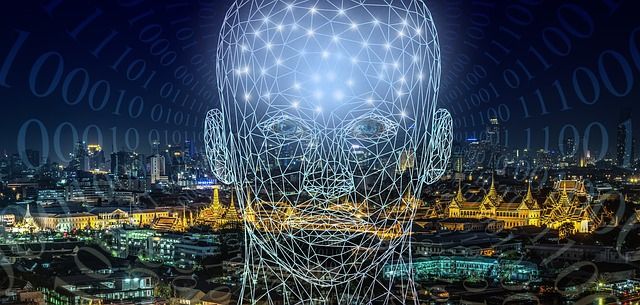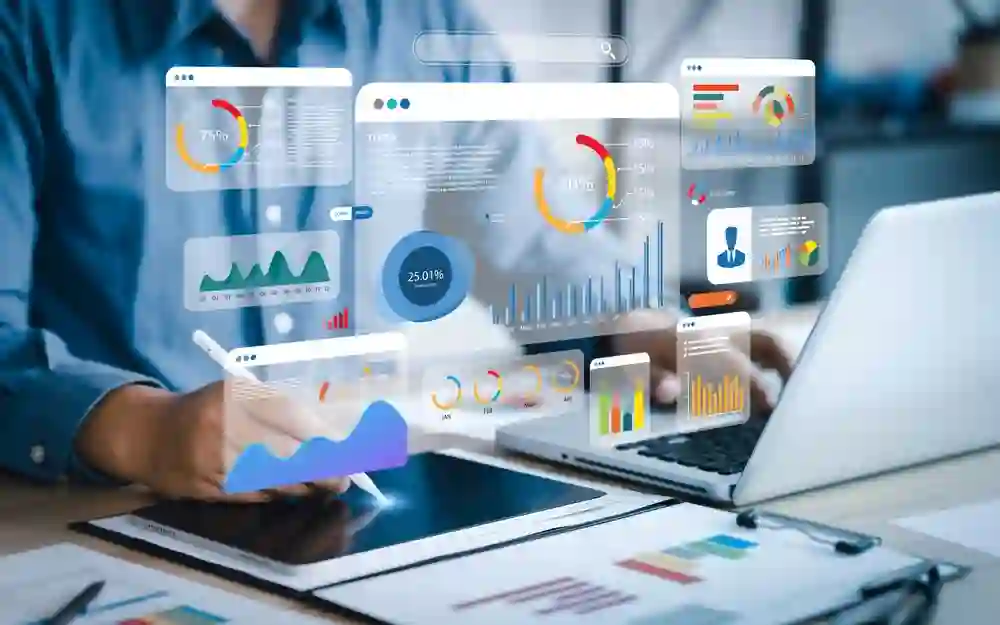Top 5 Use Cases of AI in Social Media
"Social Media" is the most interactive technology of the era. AI is influencing business and communication tactics and changing how we connect with people. In social media, it is revolutionizing how we spend our free time and improving working performance.

For the last few decades, we are observing the upsurge of numerous unprecedented tools reshaping our capabilities in one way or the other. The greatest breakthrough witnessed in the last century was the "Internet" that has been structuring the fabric of our digital existence. This breakthrough of the past century surprised the world with another juggernaut development influencing our daily lives. Yes! I am talking about the most interactive technology of the era "Social Media". It is not just transforming the ways we connect but is also influencing our business and culture. In this information age, the digital natives who have grown up surrounded by internet access can't conceive an image of life without social media platforms like Facebook, Instagram, Twitter, and YouTube, etc. According to a study conducted in the year 2021, almost 57.6% of the global population is connected to social media spending on average 2 hours and 27 minutes on daily basis. Another study reveals that the number of active social media users worldwide is 4.480 billion and that every user having a smartphone is using one social media application (Facebook, Instagram, Twitter, Tumbler, SnapChat, etc.) at the minimum.
Let's talk about another breakthrough of the modern age – "Artificial Intelligence" which is increasingly being employed in social media and is helping the social media channels at a large scale. AI in social media is further renovating the ways we spend our leisure time and boosting our business interactions and performance.
In this blog, we will explicitly discuss AI use cases in Social Media and how it is impacting our routine and business interactions.
What Entailed the Use of AI in Social Media?
Social media was initially created for people to stay connected to each other and find entertainment out of it. However, the companies soon realized that it could be a great platform to enhance their brand recognition and overall business growth, as well as to build strong customer relationships. Today, we can find the majority of the businesses on social media including Facebook and Twitter. According to research, 96% of small businesses in America are using social media. Based on the popularity of these platforms, the customers visit the social media pages of the companies even before visiting their websites. The large number of businesses joining social media resulted in fiercer competition and more demanding customers.

Moreover, both individuals and businesses are sharing their photos, videos, or thoughts on social media platforms adding about 2.5 quintillion bytes of data on daily basis. Thereby, these social media networks are flooded with inestimable users and their data. It is not child's play to manage such gigantic datasets as it demands plenty of time and brainpower to look upon.
To find the solution to these problems, the most advanced technology of the era i.e., AI was introduced in social media. The huge potential of AI is inspiring more and more social networking companies to employ AI tools at scale. A report published by Mordor Intelligence reveals the projection that the growth of the AI market for social media would be worth $3,714.89 million by 2026 that was just $815 million in 2020. According to another report, based on the huge potential of AI, the social media market valued at $633 million in 2018 and is projected to hit $2.1 billion by 2023.
Role of AI in Social Media Platforms
In this digital era, AI has become the basic element of all the well-known social networks we are using on a routine basis. Let's have a brief look at how AI is transforming the way these networks perform:
Facebook employs ML to serve you the content you are most interested in and suggest you the tag options. At the business level, it is assisting marketers to identify your face from group photos using Facial Recognition so that the ads can be targeted to the most potential customers.
Twitter is the fastest-growing social platform. It analyzes the complete image and identifies a face from it for thumbnail creation. It uses ANN (Artificial Neural Networks) to decode the part of an image that would be most liked by the user. AI also analyzes the whole content of a post and suggests the most relevant tweet for that post hence saving a considerable amount of your time and effort in reading the whole post and crafting a tweet by you.
Instagram is leveraging Fb AI algorithm to identify visuals or images. It selects the content from social media and automatically generates descriptions.

LinkedIn is employing AI and ML to offer job recommendations, serve you with the most relevant posts in your feed and suggest to you the persons you must connect with. LinkedIn parse loads of data to recommend you the job based on your interests.
SnapChat is leveraging AI and computer vision to trace your features. It contains AR filters moving with your face instantaneously to trace it.
Pinterest connects the images with Artificial Neural Networks to display that content to the users in which they are most interested. Pinterest users have saved above 240 billion pins within eleven years of its business, with 533 pins per user on average. About 80% of these users are recorded to buy the personalized content that has just been possible with AI.
This is how AI is enhancing features of the world's well-recognized social networks. An AI algorithm is working behind the scenes across all these networks to regulate the way your content or ads are displayed before the users.
Use Cases of AI in Social Media
AI is helping individuals and entrepreneurs to automate mundane tasks and monitor social media activities at scale. Let's discuss the most prevalent use cases of AI in Social Media:
- Auto generating Post Content using NLG
- Spam Detection and Filtration by AI
- AI-powered sentiment analysis and auto-response through NLP and ANN, and ML
- Optimizing Social Media Channels through AI
- Managing Social Media Advertisement with AI Predictive Technology
Let's walk through these use cases one by one:
1. Automatic Post Content Creation Using NLG
From creating a basic filler post or Instagram story to filming a viral video, humans have been struggling hard using their brainpower to limit themselves to a specific word count. Here comes AI to automatically create the content that you want to share online. An AI-powered software solution called NLG (Natural Language Generation) is used in social media platforms for post content crafting. This AI tool is trained to analyze the data and craft written narratives out of it.
Let's discuss some AI-driven Social Content Creation Platforms being used to create social content:
Lately
It is an AI-driven program to analyze long-form content and recognize context from it. AI in Lately picks the words from the long blog posts, audios, or videos and automatically generates numerous relevant short-form social posts containing those words that are most likely to gain audience engagement. Lately, also provides a dashboard for several other social tools regarding scheduling and project management. This AI-driven program analyzes the record of your social pages and suggests the best timings to share your post to get the maximum impact.
The Lately dashboard also enables you to promptly generate numerous tweets regarding a document, URL or post, by using a simple form. Once this form is filled out, you can add hashtags and information about the campaign to your social posts. By clicking "Generate Content", the tool would explore the document or URL and generate relevant tweets.

Sprout Social
It is another AI-driven platform helping celebrities, individual entrepreneurs, and large businesses to build strong relationships with clients on social media. It is mostly used to generate tweets to answer the tweet of a follower or a customer. From its dashboard, a marketer can find and respond to those tweets that are related to his company. This program also enables marketers to manage direct messages. Whether it's through the dashboard or direct message view, Sprout Social can evaluate the wordings as well as the sentiments hidden in a comment and recommends an auto-response to publish.
HubSpot
The social media software of HubSpot also analyzes the information in the link or document that you copy-paste on this platform and automatically generates social posts related to that information.
Benefits of the above mentioned AI-powered programs include:
- You don't need to go through the entire long-form content to generate a post or a tweet, thereby saving plenty of time to invest in some other creative activities.
- The post or tweet generated is fully editable, and you can review and tweak it if you feel necessary.
- These platforms help to optimize Social Media Channels.
- Such AI-powered automation enables the social media marketers to accelerate the response time to answer the customers' or followers' tweets or direct messages, hence boosting their confidence in you.
2. Spam Detection and Filtration by AI
Social networks are facilitating users to connect with their family and friends. However, these networks are also inspiring spammers to penetrate authentic users' accounts. ML algorithms such as Naïve Bayes, Random Forests, and K-nearest neighbors are being employed in social media networks to detect and filter sneaky spam messages or emails. Additionally, AI with its advanced techniques like ANN and OCR (Optical Character Recognition) is benefitting companies like Gmail in spam filtration. ML algorithms create a new rule for spam filters automatically.
Among all the social network spam, Twitter Spam remained the most critical issue to be addressed. The introduction of ML algorithms into this social network resolved the issue to great extent with an 80% accuracy rate.
Let’s have a look at some Spam Detection AI /ML models used in Social media:
ANN (Artificial Neural Network)
AI application of ANN can easily differentiate between the spammer and the legitimate account user. It notices the patterns and relationships in data then learns by itself through experience rather than programming. Google is using TensorFlow to restrict 100 million spam emails on daily basis as per the study conducted in 2019.
Naïve Bayes
It is an ML approach working on Baye's theorem. Naïve Baye employs the maximum probability method to identify the spam and filter it out. This ML model enables keyword and content-based spam filtration.
OCR
In 2003, Graham Cumming reported an image having spam text inside for the first time. Later on, this technique was extensively used by the spammers who started sending MIME attachments for image spam rather than simple image tags. Here the technique that helped in extracting the spam text from that image was none other than OCR.
3. AI-Powered Sentiment Analysis and Auto-Response Through NLP ANN, and ML
AI applications of ANN and NLP in social media have resulted in identifying the sentimental state of the user. This AI-powered solution in social media is of great value for entrepreneurs as they can analyze gigantic customer feedback data in a matter of seconds, and rank their feedbacks by sentiments to find out the most significant information from it. When a customer gives a bad review on your social media page, it influences your ranking and the buying behavior of the potential customer. Sometimes, customers leave a review on your social media page that is neither positive nor negative but somehow confusing, that you are unable to decode. Fortunately, AI in social media can help in extracting the sentiment of the customer hidden behind his review. Based on the extracted information, the business support team can identify the improvement gaps and can act with a proactive approach to avoid any bad event before it happens in the future.

Moreover, responding to the inquiry of each client on social media is a difficult task to manage by the customer representative team of a business. AI-powered chatbots have made this task quite easier enabling the customers to get prompt replies and the businesses to earn the customer's confidence. These AI-driven chatbots use ML and NLP (Natural Language Processing) to invigorate human conversation and deliver a thoughtful response to the inquiry of the customer. These AI-powered chatbots can even analyze the sentiments of the customer/user and respond to them accordingly.
Benefits of these AI-based applications include:
- More detailed insight from customer's response
- Prompt responses
- 24/7 availability for customer support
- Reduction in the service cost of the company
- Improved customer experience
4. Optimizing Social Media Channels Through AI
Managing various social media channels simultaneously is a broader term involving numerous hard tasks. Following AI-powered tools in social media are beneficial for handling different social media platforms:
Socialbakers
It is an AI-powered digital tool assisting to manage all of your social media profiles simply and perfectly. This AI tool provides the following to manage social media platforms:
- An analytics dashboard
- Audience insight
- A comprehensive content feed to enable you to find posts from all of your social media platforms
- Intelligent tools for scheduling that would be suggesting the ideal time for posts.
This AI-driven tool identifies big-impact influencers through its "Influencer Dashboard". This dashboard on Socialbakers explores various social media channels and finds out the influencers that might be the best match for your audience to target them.
Cortex: Cortex is an AI-powered tool in social media that analyzes your historical metrics and recommends the best time to share your content/post. If you upload several photos, its AI software will pick up the colors that would be engaging most of your audience to help you choose the best image for your post.
Linkfluence: It measures brand impact, identifies online trends and audience insight. It connects data from all of your social media accounts and shows you a live feed of tweets and posts that are acknowledging your brand name. In another column, it displays the scores explaining whether people on different social media channels are talking positive or negative about you. It further delivers the audience data like their languages, interests, or hashtags and identifies the social media platforms where the audience is discussing you more to respond to them in those platforms.
The above AI-powered tools deliver following benefits:
- Easily measure the success of all marketing campaigns running on all social platforms.
- Compare the success rate of all campaigns to improve the performance.
- Improve customer engagement
5. Managing Social Media Advertisement with AI Predictive Technology
In social media, AI can be employed to accelerate and streamline marketing strategies. Today, brands are marketing their products or services across social networks like Facebook, Instagram, and LinkedIn, etc. AI tools are of great help in writing social media ads that are further tuned through ML algorithms to improve CTR (Click through Rates) and conversions. The predictive technology of AI optimizes social media advertisements based on predictions about maximum clicks and conversions.
Phrasee
Phrasee is an AI-driven SaaS platform that grabs data from past emails and posts to determine which ads got more conversions and which were least effective. Hence, Phrasee identifies what features of past ads were strong enough to get customers and which were weak and need improvement. Afterward, you can create a prospective ad copy through this tool to test its usefulness, or you can go with the ad copy recommended by the software. Hence AI is helping in writing short-form ad copy for Facebook, Instagram, and other social networks.
Pattern 89
It is an AI platform used to predict creative performance of a social media ad. After creating an advertisement on the social network, this tool handles some of the fundamental tasks of ad management including optimizing bids and suggesting budget. It also recommends which social media channels your ad would be performing the best.
WordStream Advisor
It is a digital software solution for advertising management on social media. This AI tool enables advertisers to manage Facebook Ads, Google Adwords, and Bing Ads campaigns through a single dashboard. This AI tool is also used to boost up ad performance. It employs ML to analyze PPC ads running across different social media channels, thereby offering suggestions to improve the usefulness of the PPC ads.
The above AI solutions deliver following benefits:
- Help the online sellers to make better decisions about their PPC (Pay per Click) campaigns.
- Help in identifying ads that are performing the best and the most relevant target audience.
- Help in identifying the most relevant keywords to be used in ad campaigns
- Suggest optimum bid to place an ad at the top-level position of the social media page.
- Boost the performance of campaigns resulting in solid ROI.



